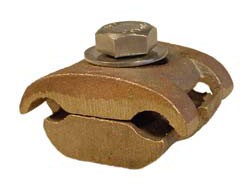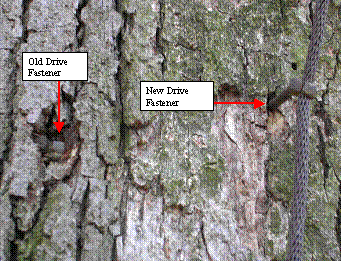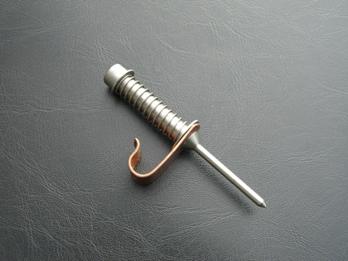BASSIS FOR ARGUMENT AS TO WHY TRADITIONAL DRIVE FASTENERS SHOULD NOT BE EMPLOYD IN LIGHTNING PROTECTION SYSTEMS AS FITTED TO TREES
VACNE – Mr. Ben Fuest from UK has sent us some articles on methods and technology of lightning protection for trees. With permission of Mr. Ben Fuest we now introduce these articles on VACNE website for our members and organizations, persons who are interested. Thanks Mr. Ben Fuest
BASSIS FOR ARGUMENT AS TO WHY TRADITIONAL DRIVE FASTENERS SHOULD NOT BE EMPLOYD IN LIGHTNING PROTECTION SYSTEMS AS FITTED TO TREES
Ben Fuest
Introduction
At the present time there exists a requirement in American National Standard that “ Existing metal support cables, guys and conduits shall be bonded to the lightning protection system”
Photo curtsey of Davey Tree Expert Co.
The purpose is to reduce potential electrical difference to the point where it no longer exists.
Where this protocol not be adhered to the electrical energy would flow down the conductor raising the electrical potential in the metallic conductive support system, but not to the same extent, hence the term potential electrical difference. Where we have a P.E.D of this nature we can expect the flow of current from the conductor to the support system, some times referred to as “side flash”. What percentage of the current, would be influenced by the impedance/resistance in the conductor and the amperage in the strike. Research by Dr Vladimir Rakov at The university of Florida suggest this could be as much as 80% ( research conducted on non dynamic structures ) Once the current has made contact with the support system we have effectively lost control and it is free to roam, looking for the alternative paths to ground. These paths may be in the form of flash over to the earth surface or to ground via the living tree tissue, most probably a combination of both.
The result of electrical energy of this magnitude entering tree tissue are well documented. To quote the ISA BMP 2ND edition Page 21
“ A steel lag or eye bolt can conduct a charge deeper into the tree, which may result in tree shattering “
An opinion shared by Dr Kim Coder in his article Spark of Death
“ Isolated metal bolts, nails and lighting fixtures can change lightning paths from exterior to interior” Arborist News, June 2004.
Bonding devices
 |
| Picture courtesy of Davey Tree |
Bonding devices for lightning protection systems are specific to task as are all lightning protection system components. They are best described in ANSI/UL 467, which states
. “ The general purpose of grounding and bonding devices is to provide a means of grounding circuits and equipment. Accordingly, any grounding or bonding device shall be acceptable for the application for which it is intended and, when installed in the intended manor, shall provide a permanent, reliable electrical bond.”.
It goes on to say.
“ The minimum electrical resistance of a bond is not specified and, in general, a grounding or bonding device that provides a substantial and reliable mechanical connection is considered to have adequate electrical conductivity. If however, a bond has any doubtful or unusual features, it shall be investigated to determine if its design and construction are such that it will carry the current that it may be called upon to handle under actual service conditions, without overheating or being adversely affected. “
Drive Fasteners
The purposes of a drive fastener is to secure the conductor to the fabric of the tree. It is driven into the tree at 6 foot intervals to a depth of approximately 1 inch, or to what one could refer to as the shoulder .The conductor is then secured at the outer end in a pinch portion. They should be of a substantial construction and sized to match the conductor cable. Having examined one in the workshop, I observe That it is 3.5 inches in length and has a diameter of ¼ inch. The construction would appear to be of solid cast copper with a light machine finish. The driven portion is best described as cylindro conical and about 1 inch in length. This is probably why there have been reports of drives falling out of the tree or rather squeezed out. Once installed they provide a stand off effect or to apply nautical terminology free board. This free board diminishes as the tree grows, the rate would be determined by species, age and, location. Once this free board has been completely taken up The recommendation in the BMP 2nd edition is to remove the conductor cable from the outer end and drive a new fastener close to or preferably touching the old.
Now what we have is a situation where the tree itself is being employed as the bonding device. Having previously examined the reasoning behind bonding, bonding devices and the associated risks of not bonding, this practice would seem nonsensical.
EMPLOYING TREE AS BONDING DEVICE YES NO
Permanent x
Reliable mechanical connection x
Adequate electrical conductivity x
Doubtful or unusual features x
Will it over heat x
Will it be adversely affected x
So I believe that while initially employing drive fasteners seems like an inexpensive solution to securing conductors to trees, ultimately it results in a practice that is in conflict with ANSI standard.
Bonding Device or Tree ?
 |
| Arlington National Cemetery |
If this practice is to be considered acceptable, the bonding of support system cables in the first picture could be considered as unnecessary as all that would be required would be to attach the conductor close to or preferably touching the support system.
Arborbolt
 The Arborbolt dynamic tree fixing is specifically designed to secure conductors to trees, accommodating incremental growth for an indefinite period. It is manufactured in stainless steel. As with all fasteners it is invasive in the first instance but unlike the traditional drive it does not require replacing. Instead it is modified in length with blanks as and when required. This means that over time it is actually less invasive than traditional technologies and completely eliminates the issue of potential electrical difference and the need for bonding through tree tissue.
The Arborbolt dynamic tree fixing is specifically designed to secure conductors to trees, accommodating incremental growth for an indefinite period. It is manufactured in stainless steel. As with all fasteners it is invasive in the first instance but unlike the traditional drive it does not require replacing. Instead it is modified in length with blanks as and when required. This means that over time it is actually less invasive than traditional technologies and completely eliminates the issue of potential electrical difference and the need for bonding through tree tissue.
In 2007 Arborbolt was confirmed as being compatible with ANSI standards.
EMPLOYING ARBORBOLT YES NO
Permanent x
Reliable mechanical connection x
Adequate electrical conductivity x
Doubtful or unusual features x
Will it over heat x
Will it be adversely affected x
THE PROSPECT OF DAMAGE TO THE TREE AND WHAT TO EXPECT
Resistance
The property of a material to resist the flow of electrical current. It is specific for a given tissue, depending on its moister content, temperature and other physical properties.
The higher the resistance of the tissue to the flow of current, the greater the potential for transformation of electrical energy to thermal energy.
“A trees inner bark and cambium are most conductive, heartwood is also conductive”
(ISA BMP 2ND Edition)
“A steel lag or eye bolt can conduct a charge deeper into the tree, which may result in tree shattering” (ISA BMP 2nd Edition)
Just how conductive remains a mystery, there has been research into this and has shown that there are too many variables to draw any definitive figures from. However the physical evidence of trees shattering under such electrical loads is over whelming.
So I suggest that the flow of current from the conductor and or fastener to fastener will result in the super heating of the interior tissue resulting in explosive forces capable of tearing the tree apart. The path this damage would take would be determined by the conductor, typically along the length of the grain and focused around areas of increased density such as branch unions and buds.
System Failure or Design Flaw
I would argue a system such as I describe would be performing in accordance with its design. So best described as a system design failure. I would also argue that with the standards in lightning protection that we have today the probability of such failure is inevitable.